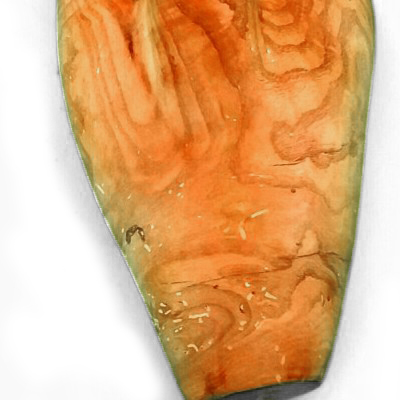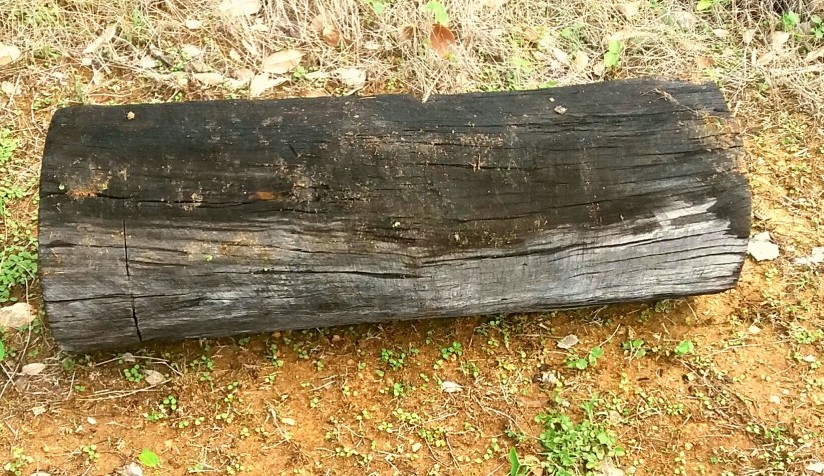
100+ year old teak utility post
My first experience with carving wood was as a little boy carving tops. Spinning tops was one of our favorite past times. The tops were carved from green tamarind or white cedar, carved with a knife, we would cut off the head of 4 to 6 penny nails, depending on the size of the top. We then insert the headless nail into the top for spinning.
There were two angles to spinning tops, one was to see whose top would spin the longest. The top that sleep the most would always win. When a top is sleeping, it just looks like it is standing still with just the spinning motion. There was an art to spinning tops, the right amount of cord for wrapping around the top, and the finish of the nail point and the technique of the spinner.
The second angle was a blood sport, the object of the game was to destroy tops. You had to aim your top with enough force to hit an already spinning top and split the green wood, while the destructive top continued spinning. Obviously you came to the game with several tops.
I did not carve again until my college days and the woods at that time were yew, walnut, or oak. My first coffee table was made from a slab of yew. Arriving back in Barbados meant easy access to mahogany. My reputation as a sculptor was built around mahogany. I may have experimented with a little local ebony, white cedar, and lignum vitae, but it was mahogany most of the time.
When my son and his mother moved back to Canada, I followed for six months a year for six years to spend quality time with my young son, while maintaining the Gallery and Gift Shop in Barbados. The months were May until the end of October. A friend introduced me to a company selling exotic woods from around the world and what a joy it was to carve the various woods. The most popular woods were mahogany, maple, ebony, ash, walnut, and zebra wood with the funny smell. Ash was a pleasure to play with the bold and distinct patterns of the grains. I still think the best carving I ever did was with ash, I wish I could remember who bought it.
Moving to Anguilla had a surprise waiting for me. A local businessman approached me one day in 1969 and said, “I hear you carve wood. Come with me, I have something to show you.” I followed him to the back of his house and there was a 6ft in diameter mahogany trunk with a few short branches. The only trees around had trunks under 3ft at the most and were a few old tamarind trees and some mahogany trees that were planted in the fifties for the Queen’s coronation.
“Give me 2000 dollars and you can have it.”

There was no hesitation, I immediately wrote him a check and made arrangements to move it. I had to fork out another $2000 dollars to move it, including a crane, a forklift, and a flatbed truck and a helper. A centurion later informed me that the tree was over 300 years old and featured prominently in the history of Anguilla.
Carving that old mahogany is like having an orgasm. It is some of the most beautiful mahogany I have ever seen or carved.
Twenty years ago, an Expat businessman had imported a dismantled 100+ year old Thai house and erected it on the island. He also had some 100+ year old 12″ teak telephone poles. They were cut up in 3 to 4 ft lengths. I am now in the process of carving small craft items from that wood. There are a few nails and some surface cracks, only small items are possible, but I am having fun.
My second choice of available wood was walnut, some South American Umbuee was available at the local hardware stores, beautiful to carve, and easy to sand. But it is no longer available due to a ban to protect the forests.
Recently, I purchased a12″ x 2″ x 9″ board of Sapele Mahogany, just for the experience. It’s the closest thing I have seen to genuine mahogany. I just completed some small bowls, carving was satisfactory, but the finish is no where as exciting as the genuine mahogany.
Conclusion
My favorite and best woods for carving that are or were available are
1. Mahogany
2. Walnut
3. Anguilla White cedar
4. Ash
5. Birds-eye maple
6. Zebra wood

Lignum Vitae could be added to the list, but sparks fly from the chain saw and given the wear and tear on tools, it must be regarded as the occasional luxury. Purpleheart and Greenheart from Guyana are available to carve, but are too hard to enjoy carving, plus Greenheart has too many surface cracks.
Give me the old mahogany tree any day. Visitors some times bring me samples of wood to carve. One gentleman from the USA brought me a sample of beautiful walnut and a wood that have baffled everyone, even the gentleman himself, and several people in the forestry business.
If anyone recognizes this wood, I will be more than happy to hear from you. Several wood merchants and two foresters could not identify it. I have been pondering over this piece of wood for the last two years. A few nights ago I recalled a carving from over 40 years ago I considered to be one of my best carvings, the wood was Ash, could it be?



12 comments on “What is the Best Wood for Carving”
Kevin And Jade
I read your post and I got goosebumps. I could really feel how much you love wood carving and that’s such a beautiful thing because very few people live their passions anymore.
I don’t personally have any experience with carving wood but I’ve always had a romantic view towards it. Being able to touch something so warm and beautiful and release what’s inside it – it must be bliss.
Forgive the silly question but I always wondered if wood carving is as therapeutic as books claim they are. Is it?
Anyway, thank you for sharing your thoughts. It was a lovely experience.
Courtney Devonish
It’s strange but I am a ceramic artist as well as a wood carver, ceramics is suppose to be therapeutic, but I find wood carving more therapeutic; I suppose it depends on the individual. My work is designed for touching. Thanks for visiting. Best wishes.
RoDarrick
Excellent post you have up here concerning the best wood to use in carving. Though I have see some beautiful carvings and excellent works of creativity but I do always wonder the kinds of trees used as wood for such craftsmanship. Knowing more about the kind of trees used in making these magnificent art works is always a welcomed addition in enriching my knowledge in art and crafts. Thanks for this post
Courtney Devonish
I have stopped collecting wood, I am trying to work through a 40ft container of planks and logs; a few years ago when the warnings went out of a pending ban on mahogany, I bought the remaining stock of one and two inch thick boards from a local lumber yard; there is no more two inch left and about 12 boards of one inch. What is available now is a substitute- Sapele, not as rich as mahogany. Blessings
Henderson
You must really love your woods the way you speak about them with so much expertise. My dad was a woof collector in the past and he sold them for quite high prices. Then he collected mostly oak and mahogany and they were his love. I can’t say for sure which wood is the best but I really did love awesome carvings. You are a guru to the wood I must say. Great one.
Courtney Devonish
Thanks for the compliments, one of our local hardware stores is selling oak which was a surprise, mahogany is no longer available, and I must confess is my preference for its character and richness. Best wishes.
SpiritualFitness
Your love of wood carving and the excitement of a 300 year old tree is contagious! It fascinates me how the mind works … sometimes the simple things in life, like a very special mahogony tree, brings out the passion, brilliance and inspiration to create these stunning works of art.
I got to carve some wood blocks over the years, and I sure see how that is therapeutic. I’m not a professional but love to dabble with it, and I can see how a person such as yourself gets lost (or at peace) in the creation! Thanks for sharing this insightful post.
Courtney Devonish
Thank you, its also more than just carving wood, I find great pleasure in creating or redesigning some of the tools to help save time and give a better finish, I remember a tool 3M discontinued, I went out and bought any stock I could find, It was a great tool, just needed an adjustment. I am cherishing my collection which does wonders to my finish. A few years ago I carved 75 trays for a 3M incentive group, but they had already dismantled the production line when I spoke to one of the leaders. Best wishes.
Stuart
What a wonderful look at an experts view on wood for carving, I am not, never have been, one who carves in wood, but found your comments about the different woods, the feel and what you could do with them almost romantic. It must be wonderful to be so gifted.
Many thanks,
Stuart
Courtney Devonish
I love working in wood, but I am also a ceramic artist, but have not done any new for the last2 years and customers along with my wife are pressuring me every day to create more ceramics, but the mood is not there yet. Enjoy your day. Thanks for the visit.
Gravatar Support
I can see you have a great passion for wood carving. How did you know he enjoy this activity?
Some questions:
1. Does different woods produce different types of carving
2. Do you have more pictures of your wood carvings? It will be great to show more.
3. Are there certain woods that will keep away flying insects?
Thank you for sharing.
Courtney Devonish
Neem is reputed to have qualities as an insecticide; different woods carve different, a hard wood is easier to carve and sand than a soft wood, there are some woods that are a challenge, green heart, lignum vitae, and iron wood among them. See devonishart.com for more views of my work. Best wishes.